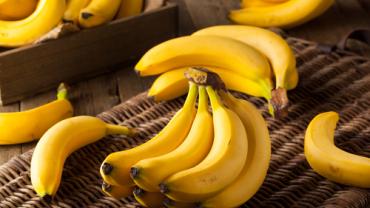
Has fructo-phobia gotten to you?
Have concerns about the dangers of excessive added fructose in processed foods made you terrified to eat wholesome foods that contain even small amounts of naturally occurring fructose? When it comes to fruit, perhaps you stick to eating lower fructose items, such as raspberries and blueberries, and merely hearing the word “banana” is enough to scare you. If so, take a breath and prepare to reconsider blacklisting bananas.
There may, indeed, be people who are better off avoiding bananas most of the time. This could be true of those who must tightly control their blood sugar, or who have health issues related to insulin resistance and/or high blood glucose. But it would be misguided to banish bananas from everyone’s diet, considering they’re a whole, unprocessed food that millions of people in tropical areas have been consuming for ages, with no detrimental effects on their health.
Bananas are not as nutrient-rich as certain other fruits, such as blackberries or pomegranates, but that doesn’t mean they’re nutritionally void. Far from it, in fact. They’re a good source of vitamin C, B6, manganese and magnesium, and bananas (along with potatoes and avocados) are often cited as rich sources of potassium. As for the carbohydrate content, one medium-sized banana (about 7-8 inches long) contains 27g total carbs broken down as follows: 3.1g fiber, 6.3g starch, 2820mg sucrose, 5876mg glucose, and 5723mg fructose. Sure, bananas have more sugar (and fructose) than, say, lemons, but they’re not exactly toaster pastries or cake frosting loaded with high fructose corn syrup. Foods fall along a spectrum, and it’s important to keep things in perspective.
While some individuals might be well advised to skip bananas, other people might find they fit quite well into their habitual diet, and may even be of specific benefit. For example, bodybuilders and other individuals who exercise intensely might find that adding a banana to their post-workout meal may help them replenish glycogen so they’re ready to hit things hard again at their next workout. And while the effects of chronically elevated insulin can be disastrous for many, an acute and transient rise in insulin after a workout can be helpful for shuttling amino acids into muscle tissue and potentially facilitating muscle growth. (Plus, adding a banana to a protein shake can make it thicker and perhaps more palatable and enjoyable.)
Some people only eat bananas that are perfectly ripe and 100% yellow, with nary a single speck of brown. Others prefer to wait until a banana is a bit over-ripe, and it’s softer and sweeter. (Brown, squishy, overripe bananas need not be destined for the trash can or compost bin! They’re a great reason to make grain-free banana bread). Most people avoid eating under-ripe green bananas because they’re firmer and not as sweet as ripe specimens. (They taste and feel more like plantains.) But green bananas, and the “flour” made from them when they’re dried or dehydrated, have some interesting properties. These are largely due to the presence of resistant starch in unripe bananas. Resistant starch is a kind of carbohydrate that is “resistant” to digestion, and proceeds through the GI tract until bacteria in the large intestine break it down via fermentation. This may result in increased intestinal gas, but there are beneficial byproducts of this fermentation as well. Having something to feed on may help keep the bacterial population healthy, and there is increasing recognition of the influence of adequate and diverse “gut flora” on physical and mental health.
Resistant starch is present in many foods, but an unripe banana, specifically, has been shown (in rats) to improve insulin sensitivity. Overweight women with metabolic syndrome who consumed 20 grams of green banana flour a day for 45 days showed small but noteworthy reductions in fasting blood glucose and systolic blood pressure, but there were no changes in body weight or body composition. Resistant starch in general may reduce post-meal rises in blood glucose, whether the starch comes from unripe bananas or another source.
If you’re ready to jettison your fear of fructose, or perhaps never felt it in the first place, there are plenty of grain and dairy-free ways to use bananas. Consider 3-ingredient banana pudding, banana muffins, strawberry banana “ice cream,” and for a truly indulgent snack, there’s chocolate bacon almond butter bananas…hello! (And there are endless variations on the tried and true, banana bread.)
Sources